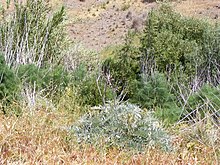This article needs additional citations for verification. (September 2023) |


Invasive species in Australia are a serious threat to the native biodiversity, and an ongoing cost to Australian agriculture.[1] Numerous species arrived with European maritime exploration and colonisation of Australia and steadily since then.[2] There is much ongoing debate about the potential benefits and detriments of introduced species; some experts believe that certain species, particularly megafauna such as deer, equids, bovids, and camels, may be more beneficial to Australia's ecosystems than they are detrimental, acting as replacements for extinct Australian megafauna.[3][4]
Management and the prevention of the introduction of new invasive species are key environmental and agricultural policy issues for the Australian federal and state governments. The management of weeds costs A$1.5 billion on weed control and a further $2.5 billion yearly in lost agricultural production.[5]
- ^ "Invasion timeline". Invasive Species Council. Retrieved 31 December 2023.
- ^ Evans, Jessica; Brazenor, Alexander; Hennecke, Bertie; Parsons, Sandra (5 January 2023). "Exotic invasive species with environmental impacts (Overview)". agriculture.gov.au. Retrieved 5 September 2024.
- ^ Cite error: The named reference
Lundgrenwas invoked but never defined (see the help page). - ^ Xavier La Canna, September 12, 2017, Australia's introduced animals: Eradication programs under the spotlight, Australian Broadcasting Corporation
- ^ Impact of Weeds Department of the Environment and Energy. Retrieved 22 November 2016.